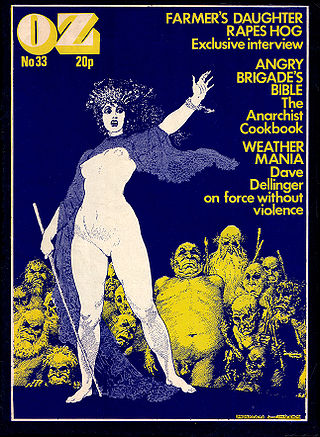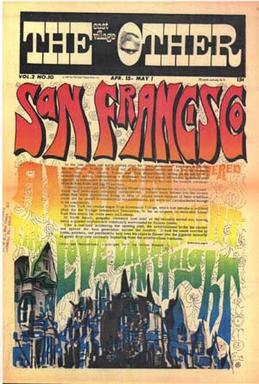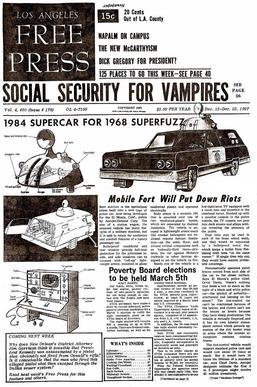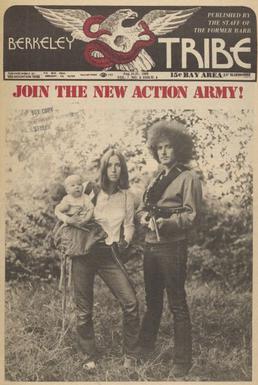Pittsburgh Fair Witness was a radical counterculture underground newspaper published in Pittsburgh, Pennsylvania from 1970 to 1973. The first 9 monthly issues were published starting in February 1970 under the title Grok. Beginning with vol. 1, no. 10 (Nov. 4-25, 1970) the title was changed to Pittsburgh Fair Witness and the paper shifted to publication once every three weeks; starting with the Dec. 3–17, 1971 issue it published on a biweekly schedule until its demise with vol. 4, no. 6 (June 1973). [1] The PFW was staff-owned and published by a collective that called itself "The Commune." An editorial published in the May 26, 1972 issue under the heading "Our Rap" gives the paper's statement of purpose:
"The Fair Witness is published by a non-profit collective and is dedicated to the worldwide movement of people to control themselves—the movement to break down the authoritarian systems of government that are denying us our basic freedoms, that are responsible for needless genocidal wars, the perpetration of minority discrimination, the pollution of our environment and our bodies, the high concentration of power among the wealthy classes, exploitation of the individual, etc. The paper is dedicated to the struggle of all peoples to gain back the right to their own lives, the struggle to raise the consciousness of the world as a whole, the struggle to become independently productive through a working knowledge of the tools at our disposal. As a local paper our most important function concerns the movement here in western Pennsylvania."
The two titles Grok and Fair Witness are both references to the novel Stranger in a Strange Land by Robert A. Heinlein, a popular touchstone of the 1960s hippie counterculture. To "grok" is a form of deep holistic comprehension of any thing or situation (similar to hippie/beatnik slang "dig"); while a "Fair Witness" is a (fictional) service provided by a sort of hired court reporter with an eidetic memory who serves as a totally honest bonded eyewitness at any proceeding.
Contents of the Fair Witness were the usual 1960s underground press mix of underground comix (some originating locally in the Fair Witness; others like Crumb, Bode, etc. distributed nationally through the Alternative Features Syndicate), film, music, and book reviews, coverage of drugs, the occult, New Left and antiwar political activism, the Women's Liberation movement, ecology, etc.; along with local advertising and event and switchboard listings. It was a member of the Underground Press Syndicate and the Liberation News Service. A typical tabloid sized issue ran to about 24 pages and sold for 25 cents.
The Fair Witness was distributed throughout the western Pennsylvania area and locally through a network of about a hundred local shops (head shops, co-ops, record stores, boutiques, book stores, natural food stores, etc.) and was sold on the street by hawkers who kept a dime for every 25 cent copy they sold, picking up bundles for street distribution at The Free People's Store, a co-op on Meyron Avenue in the city's Oakland neighborhood.

Fifth Estate (FE) is a U.S. periodical, based in Detroit, Michigan, begun in 1965, and presently with staff members across North America who connect via the Internet. Its editorial collective sometimes has divergent views on the topics the magazine addresses but generally shares an anarchist, anti-authoritarian outlook and a non-dogmatic, action-oriented approach to change. The title implies that the periodical is an alternative to the fourth estate.

A counterculture is a culture whose values and norms of behavior differ substantially from those of mainstream society, sometimes diametrically opposed to mainstream cultural mores. A countercultural movement expresses the ethos and aspirations of a specific population during a well-defined era. When oppositional forces reach critical mass, countercultures can trigger dramatic cultural changes. Prominent examples of countercultures in the Western world include the Levellers (1645–1650), Bohemianism (1850–1910), the more fragmentary counterculture of the Beat Generation (1944–1964), and the globalized counterculture of the 1960s (1965–1973).

The British counter-culture or underground scene developed during the mid 1960s, and was linked to the hippie subculture of the United States. Its primary focus was around Ladbroke Grove and Notting Hill in London. It generated its own magazines and newspapers, bands, clubs and alternative lifestyle, associated with cannabis and LSD use and a strong socio-political revolutionary agenda to create an alternative society.

The terms underground press or clandestine press refer to periodicals and publications that are produced without official approval, illegally or against the wishes of a dominant group. In specific recent Asian, American and Western European context, the term "underground press" has most frequently been employed to refer to the independently published and distributed underground papers associated with the counterculture of the late 1960s and early 1970s in India and Bangladesh in Asia, in the United States and Canada in North America, and the United Kingdom and other western nations. It can also refer to the newspapers produced independently in repressive regimes. In German occupied Europe, for example, a thriving underground press operated, usually in association with the Resistance. Other notable examples include the samizdat and bibuła, which operated in the Soviet Union and Poland respectively, during the Cold War.

The East Village Other was an American underground newspaper in New York City, issued biweekly during the 1960s. It was described by The New York Times as "a New York newspaper so countercultural that it made The Village Voice look like a church circular".
The Underground Press Syndicate (UPS), later known as the Alternative Press Syndicate (APS), was a network of countercultural newspapers and magazines that operated from 1966 into the late 1970s. As it evolved, the Underground Press Syndicate created an Underground Press Service, and later its own magazine. For many years the Underground Press Syndicate was run by Tom Forcade, who later founded High Times magazine.

The Los Angeles Free Press, also called the "Freep", is often cited as the first, and certainly was the largest, of the underground newspapers of the 1960s. The Freep was founded in 1964 by Art Kunkin, who served as its publisher until 1971 and continued on as its editor-in-chief through June 1973. The paper closed in 1978. It was unsuccessfully revived a number of times afterward.

The Great Speckled Bird was a counterculture underground newspaper based in Atlanta, Georgia from 1968 to 1976 and 1988 through 1990. Commonly known as The Bird, it was founded by New Left activists from Emory University and members of the Southern Student Organizing Committee, an offshoot of Students for a Democratic Society. Founding editors included Tom and Stephanie Coffin, Howard Romaine and Gene Guerrero Jr. The first issue appeared March 8, 1968, and within 6 months it was publishing weekly. By 1970 it was the third largest weekly newspaper in Georgia with a paid circulation of 22,000 copies. The paper subscribed to Liberation News Service, a leftist news collective. The office of The Great Speckled Bird at the north end of Piedmont Park was firebombed and destroyed on May 6, 1972. In a letter to the editor of the New York Review of Books, Jack Newfield et al. note that the bombing occurred after the paper published an exposé of the mayor of Atlanta.

The San Diego Door, was an underground newspaper that thrived from January 1968 to August 1974 in San Diego and San Diego County, Southern California.

San Francisco Express Times was a counterculture tabloid underground newspaper edited by Marvin Garson and published weekly in San Francisco, California from January 24, 1968, to March 25, 1969, for a total of 62 issues, covering and promoting radical politics, rock music, arts and progressive culture in the Bay Area. It was a member of the Underground Press Syndicate, and sold for 15 cents.

Quicksilver Times was an antiwar, counterculture underground newspaper published in Washington, DC. Its first issue was dated June 16, 1969, with Terry Becker Jr., a former college newspaper editor and reporter for the Newhouse News Service, the main instigator in the founding group of antiwar activists. It ran for 3 years, with its final issue appearing in Aug. 1972. Publication was irregular and during the latter part of its run it was publishing once every 3 weeks. It was a member of the Liberation News Service and the Underground Press Syndicate. Quicksilver Times was one of several anti-government underground papers of the period now known to have been infiltrated by government informants.
Willamette Bridge was an underground newspaper published in Portland, Oregon from June 7, 1968, to June 24, 1971. In the spring of 1968, several groups of people in Portland were discussing starting an "underground" newspaper in Portland, similar to the Los Angeles Free Press or the Berkeley Barb. They were partially motivated by a frustration with the reporting in the mainstream press, which was still supporting the Vietnam war, opposing progressive movements like the United Farmworkers Union, and showed no understanding at all of the growing "Counterculture" and its music, dress and mores. On the other hand, they saw many things going on in the city that were positive, but isolated- Antiwar activity at Reed College, "Hippies" gathering around Lair Hill park, the progressive wing of the Democratic Party gathering strength, craft stores and head shops opening around town, local bands like The Great Pumpkin and The Portland Zoo giving concerts. A newspaper could bring these groups together and break the information monopoly of the daily papers.

Philadelphia Free Press was a 1960s era underground newspaper published biweekly in Philadelphia, Pennsylvania from 1968 to 1972. Originally launched at Temple University in May 1968 as the monthly Temple Free Press, it separated from Temple and became the Philadelphia Free Press in September 1968.
Distant Drummer was a 1960s counterculture underground newspaper published in Philadelphia, Pennsylvania, United States from November 1967 to July 1979. It changed titles twice: from October 2, 1970 to August 12, 1971 it was Thursday's Drummer, and subsequently it was known simply as The Drummer until its demise in 1979, after a run of 568 issues. It was a member of the Underground Press Syndicate and also used material from the Liberation News Service.

The Berkeley Tribe was a radical counterculture weekly underground newspaper published in Berkeley, California from 1969 to 1972. It was formed after a bitter staff dispute with publisher Max Scherr and split the nationally known Berkeley Barb into new competing underground weeklies. In July 1969 some 40 editorial and production staff with the Barb went on strike for three weeks, then started publishing the Berkeley Tribe as a rival paper, after first printing an interim issue called Barb on Strike to discuss the strike issues with the readership. They incorporated as Red Mountain Tribe, named after Gallo's one gallon finger-ringed jug of cheap wine, Red Mountain. It became a leading publication of the New Left.

Spokane Natural was an underground newspaper published biweekly in Spokane, Washington from May 5, 1967, to November 13, 1970, by the Mandala Printshop, and edited by Russ Nobbs. It belonged to the Underground Press Syndicate and the Liberation News Service. The first issue was produced out of a converted barbershop storefront cum bookstore and hangout called the "Hippie Mission" on a cul-de-sac in Spokane, where Russ Nobbs and a visiting friend from the SF Bay area, Ormond Otvos wrote and produced the first 8-page issue on a hand-cranked Spirit duplicator. After several issues of pale blue "Ditto" print on white paper, The Natural moved to colored papers and occasionally colored ink with a Gestetner Mimeograph duplicator. Ultimately, the newspaper was printed on newsprint by sheet fed or web presses by various printers in Spokane, Seattle and Davenport, WA.
Sabot was a brief-lived underground newspaper published in Seattle, Washington by the Seattle Liberation Front from September 11, 1970 to January 13, 1971. Sixteen weekly issues were published in all. The paper was started as a replacement for the Seattle Helix which had published its last issue in June 1970. As with its predecessor, Sabot was from the beginning torn by political dissension within the radical political collective, centering on an internal struggle with feminists over issues of male chauvinism and editorial control and direction. After a few months the divided staff was no longer able to get an issue out and the newspaper quit publishing.

Hundred Flowers was an underground newspaper published in Minneapolis, Minnesota from April 17, 1970 to April 4, 1972. It was produced by a communal collective, with the main instigator being antiwar activist and former Smith College drama instructor Ed Felien. The 16-page, two-color tabloid was published weekly and cost 25 cents, circulating about 5,000 copies.

Old Mole was a radical New Left oriented underground newspaper published in Cambridge, Massachusetts from September 1968 to September 1970. Old Mole was continued by a second volume titled The Mole, which published five issues from November 1970 to April 1971. Printed biweekly in a 16-page tabloid format, Old Mole was based for most of its existence in a storefront and basement office on Brookline Street in Central Square. Selling for 15 cents, 47 issues were published in all, with press runs averaging 8000 to 10,000 copies. Subscriptions were free to prisoners and soldiers.